Abstract
Background:
Village Health and Nutrition Day (VHND) is a community-based health service package delivered on a fixed day approach. Services like early registration of pregnancy, regular antenatal care and postnatal care, growth monitoring and referral of sick children, discussion of health topics to generate awareness, and convergence between health and ICDS, are delivered every month at VHND at the Anganwadi Center. This study explores the awareness, perception and practice of service providers, and beneficiaries, regarding VHND.
Materials and Methods:
It was a cross-sectional study conducted in Odisha during December 2009–November 2010. Personal interviews were conducted at the VHND sessions with 111 beneficiaries and 45 service providers using a semi-structured schedule to know their awareness, perception and practice regarding VHND sessions. Data analysis was done and reported as simple percentages.
Results:
Most of the health worker females and anganwadi workers considered health awareness as a key component of VHND. 52% of HWFs and 41% of AWWs had misconception about additional roles and responsibilities. 34% of beneficiaries had knowledge regarding fixed day approach of VHND, while 24% did not have knowledge regarding any of its purpose. Only 8% of referral cases had complete knowledge on the reason of referral. There was significant difference in between awareness and practice among the blocks.
Conclusion:
Service providers’ orientation should be improved. Behavior change communication activities should also be increased by the state. Referral cases should be properly counseled. The community believed that such a program should continue with better package and quality of services.
Keywords: Child health, community-based health services, community health workers, health education, knowledge attitude practice, maternal health, reproductive health, nutrition
Introduction
The concept and operational guidelines of Village Health and Nutrition Day (VHND) was conceptualized by National Rural Health Mission (NRHM) with support from Maternal Health division of Government of India and United National Population Fund (UNFPA), India to address some of these issues.[1,2] Guidelines developed by Government of India plans on providing an integrated service delivery of both Reproductive and Child Health (RCH) services and Immunization on a fixed day in a month, i.e. Wednesday.[2] In the state of Odisha, the guidelines were modified in 2009 and adopted as Mamata Diwas,[3] in which Mamta Diwas was planned to he held on a fixed day not included with Fixed Immunization Day (FID), and health and nutrition services to the mother and children would form a priority in it. Mamata Diwas provides the first point of contact for essential primary health care and is a common platform for convergence among service providers of Health and Integrated Child Development Scheme (ICDS) along with the community at large.
Within the purview of the program,[4] the target beneficiaries are pregnant women, lactating mothers, children below 5 years and adolescent girls, through presently there are minor changes made to the guidelines in Odisha. Basic components of reproductive and child health services, including early antenatal registration, de-worming, counseling on early breastfeeding, identification and timely referral of high-risk cases of children and pregnant women, as well as antenatal and postnatal care are to be provided at community level in order to address the essential requirements of pregnancy, delivery, referral, childhood illnesses and adolescent health.
VHND is organized once in a month in every village at an Anganwadi Centre (AWC) on a fixed day basis (either Tuesday or Friday) with joint efforts of Health Worker Female (HWF), Anganwadi worker (AWW) and Accredited Social Health Activist (ASHA). On an average, a health sub-center (HSC) has 6–8 AWCs and an equal number of VHND sessions in a month (now slightly more). The detailed microplan of such activities is developed beforehand at the block level.
The objectives of Mamata Diwas[4] are to provide essential and comprehensive health and nutrition services to pregnant women, lactating mothers, children (0–5 years) and adolescent girls; early registration, identification and referral of high-risk children and pregnant women; providing an effective platform for interaction of service providers and the community (through Gaon Kalyan Samiti[5] or the mothers group); providing information to families on care of mothers and children at the household and community level through discussion of various health topics (as envisaged in the Health Calendar); and establishment of linkage between health and ICDS so as to promote maternal and child survival programs. Children identified with severe degree of malnutrition in each VHND session are referred and treated at the “Pustikar Diwas”[6] held at the block level health center accompanied by ASHA or AWW.
During a preliminary visit to a VHND session, it was observed that the service providers were not aware of the guidelines and regarding the nature of various services to be delivered at VHND. Similarly, the beneficiaries were also not aware about the program components. Involving a lot of resources without having proper knowledge and awareness of workers and community at large would not yield expected results. Hence, this study was planned with an objective to study the awareness, perception and practice (APP) of service providers and beneficiaries regarding various aspects of VHND.
Material and Methods
A cross-sectional study was designed to be carried out in Jagatsinghpur district for a period of 1 year (December 2009–November 2010) for the evaluation of VHND services. The study was mostly quantitative, with some qualitative aspects. Since there have been no documented studies regarding awareness on VHND in India, an awareness level of 40% regarding VHND sessions held was selected with confidence limits of 10% that gives a sample size of 92 at 95% confidence levels. Multistage stratified random sampling design was adopted and stratification was done based on the prevalence of severely malnourished children [Table 1] in each block.[7] Three blocks were selected, one each from the three strata randomly. This process was followed to ensure feasibility during field visit while avoiding selection bias. All VHND sessions (total of 426) held in the district were listed and included in the sampling frame. Random sampling without replacement (to avoid duplication of HSC area) was used to identify 5% (i.e., 23) of the HSCs where the study was planned. The present research is a part of the main study. APP study was planned though interviews with at least five beneficiaries, a HWF and an AWW at each session site. This sample size was selected as it is considered adequate and feasible for evaluating health programs. Exit interviews with beneficiaries were done along with personal interviews with the service providers. Pre-tested and pre-designed semi-structured interview schedules, differing for the service providers and beneficiaries, were used to assess the awareness, perception and practice.
Table 1.
Stratification of the blocks according to the distribution of severe malnutrition
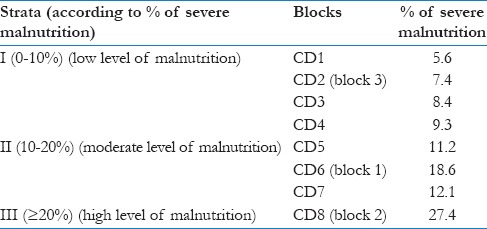
VHND sessions were visited on Tuesdays and Fridays of the week and only one VHND was evaluated in a single visit. The session timings were usually from 8 AM to 1 PM. Beneficiaries were randomly selected from the sessions. Written consent, in local language, was taken from the beneficiaries and service providers. Interview with at least five beneficiaries in each VHND session and one each with HWF and AWW was done in these sessions. Awareness, perception and practice of service providers and beneficiaries were assessed in these interviews. Similarly, knowledge regarding their roles and responsibilities for the sessions was also assessed from individual service provider. Awareness regarding the reasons for referral was also assessed during the process. The response from all the beneficiaries and service providers was captured using the instrument. Lead questions were avoided during the whole interview process.
The data collected was cleaned and entered into Microsoft (MS) Access Database 2007. Cross tabulation was done and presented as frequencies and percentages. Sub-group analysis was also done to find out if there was difference in awareness between the blocks. Open ended questions were analyzed manually. Any answer close to an objective or purpose of VHND was considered as having awareness regarding the same.
Results
Awareness, perception and practice of service providers and beneficiaries were assessed at 5% of the sessions [Table 2]. A total of 23 interviews with the HWF and 22 with AWW (one was on leave) of the sessions were done [Table 3] at the 23 sessions visited [Table 4]. Similarly, 111 interviews were conducted among all the beneficiaries, including 11 with referral cases [Table 3]. Each interview roughly lasted for 20–40 minutes.
Table 2.
Number of VHND sessions for evaluation (sample size for the whole study)
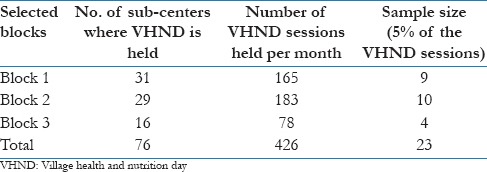
Table 3.
Number of interviews done to assess awareness, perception and practice of stake holders
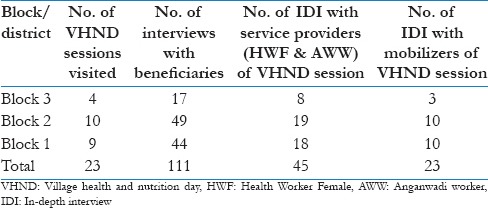
Table 4.
VHND sessions visited in different blocks for assessment of functioning
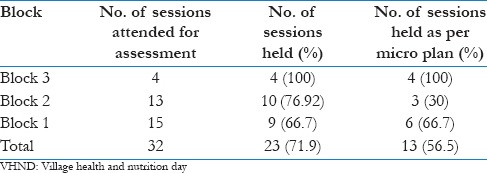
Awareness, perception and practice among service providers
The service providers were assessed with respect to knowledge on the purpose and objectives of the VHND (refer Table 5 for the five objectives of VHND). More than 80% of the service providers [Table 5] were having awareness that the major purpose of the VHND sessions was to create health awareness followed by more than 85% who cited comprehensive health and nutrition services. Promotion of maternal and child health programs through linkage between health and ICDS, was being ignored by all the AWWs (100% not aware) and by 65% of the HWFs. High-risk case identification as an objective could be recollected by only 50% of them [Figure 1]. All the service providers present at the session sites did not have complete knowledge about all their roles and responsibilities. Few verbatim of the interview are as mentioned under.
Table 5.
Knowledge of service providers regarding objectives/purpose of VHND
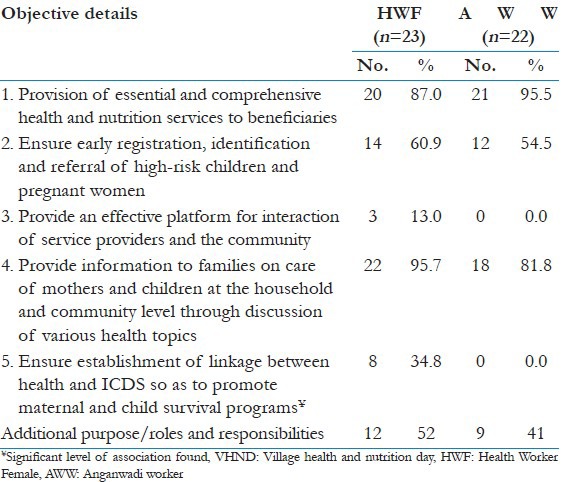
Figure 1.
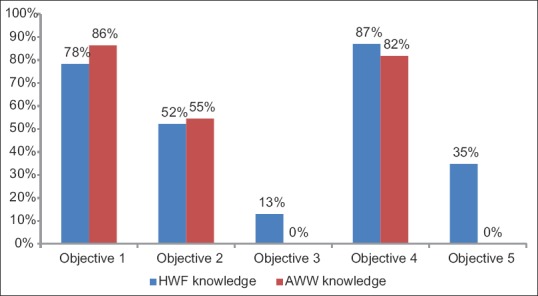
Awareness of service providers regarding various objectives of VHND
“My job during health day includes informing the beneficiaries, arranging the session site, weighing children” [An AWW].
“During health day, we give health message and do pregnancy check up” [A HWF].
“In the morning when we come to the session, we ask the ASHA to call everyone” [A HWF and an AWW].
“In VHND we provide health check up and weight measurement is being done. Also we give health education” [A HWF].
“I have been told by health authorities to conduct between 8 AM and 1 PM, but in this area the Sarpanch requested me to conduct after 2 PM. 2–4.30 PM is the convenient time where mothers have finished their activities and mothers working in paddy fields also return home. Hence, I conduct after 2 PM” [A HWF].
On analyzing the awareness of service providers regarding the purpose of the VHND sessions, it was found that service providers from a block (block 1) were having significantly less knowledge on providing integrated health and nutrition services as a purpose, in comparison to other blocks [Table 6]. When the AWWs’ and HWFs’ knowledge were compared with respect to all the purposes, establishing linkage between health and ICDS to promote maternal and child survival programs was seen as a priority for HWFs as compared to AWWs [Table 5]. There was no significant difference with regards to any other component.
Table 6.
Awarenes, perception and practice regarding objectives of VHND among service providers: Block wise analysis^

Awareness, perception and practice among beneficiaries
Almost one third of the beneficiaries (38 beneficiaries or 34.2%) had visited VHND session for the first time [Table 7]. A total of 57 (51.4%) beneficiaries were aware that VHND is held every month in their area. Awareness of the beneficiaries with regards to day, week and place of the program in their area was compared with that provided by the HWF (and not with the VHND micro plan). Knowledge regarding the place and time where VHND session was held was present in 71 (63.9%) and 85 (76.6%) respectively of the 111 beneficiaries interviewed. But only 57 respondents (i.e., 51.4%) of the 111 interviewed were having knowledge regarding the day when VHND was held (i.e., they could say that VHND was held on Tuesday/Friday). Of these, 19 beneficiaries (17%) were not having knowledge about the exact day (i.e., 1st week/2nd week etc.). Hence, only 38 beneficiaries (34.3%) interviewed were having correct knowledge regarding the fixed day on which sessions were held in their area. But 17% of the beneficiaries revealed that the sessions being conducted at an inconvenient time.
Table 7.
Key information from respondents about VHND services (n=111)
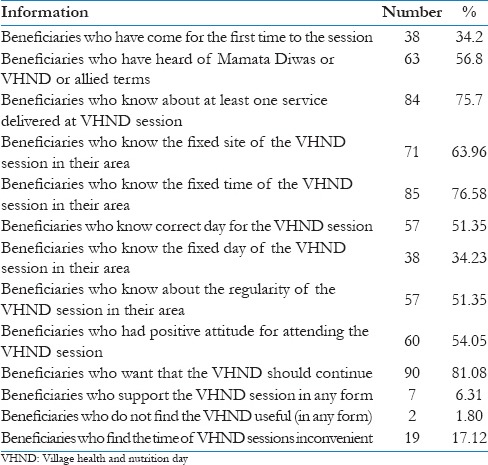
When they were questioned regarding purpose of these sessions, the beneficiaries said that delivering health messages, followed by weighing for children and pregnant women was the main purpose for conducting VHND session. No other major reasons were cited. Large proportions (24%) were not aware why the sessions are conducted. Similarly, around 50% of the beneficiaries did not know if the VHND sessions were held regularly.
Almost one fourth of them (24%) were not having any knowledge regarding any of the purpose of VHND. The beneficiaries who were at least aware that health meeting is done or some health message is being given at the sessions was 59 of the 111 responses (53.2%) (Not shown in the table). Weighing children (53 of 111, i.e., 47.7%) and weighing pregnant woman (49 of 111 or 44.1%) were the other most common answers.
Referral services availed by the beneficiaries within the last 3 months, were also assessed [Table 8]. Referral services had been availed by 13 beneficiaries (12%), out of which only one had correct and complete knowledge regarding the cause for referral. The rest (92%) had incomplete or incorrect knowledge. A probable reason could be lack of proper counseling of these referral cases.
Table 8.
Awareness about the referral services (n=13)

About 81% of the beneficiaries were in favor that the VHND program should continue with expectations to get additional services from the government. A meager 6% of the sessions had community participation with beneficiaries volunteering to organize the session. A few beneficiaries (2%), however, did not find VHND sessions useful for them, probably as they were not aware regarding the services. Verbatims of some of the beneficiaries are mentioned as follows.
“We do not know why we have come here. ASHA told that there is a meeting” [A mother].
“No I do not know why the HWF told me to visit medical, I am not aware of the reason for referral” [A mother].
“We do not know when the meeting (VHND) is held, whenever we are called we came to attend” [A pregnant woman].
“No one informs us day before the session, we are called in the morning” [A mother].
“We were told that some officer has come to visit, so came to the Anganwadi center” [A mother].
“Now we know that VHND is held on Friday in our village, which Friday we do not know. We are called upon on the day” [A lactating mother].
“There is a discussion about some health topic on this day. Weight measurement is also done” [A mother].
“We are not able to attend the session as we have to go to work, time is inconvenient” [A mother working as daily laborer and a mother working as a reaper in paddy fields].
Interesting thing to note was that awareness of beneficiaries belonging to block 3 regarding session site, day and time of the sessions was significantly less [Table 9]. Added to these were few other practices with almost significant difference like beneficiaries not being mobilized by any one and beneficiaries attending the session for the first time in this same block.
Table 9.
Awarenes, perception and practice regarding various components of VHND: Block wise analysis^
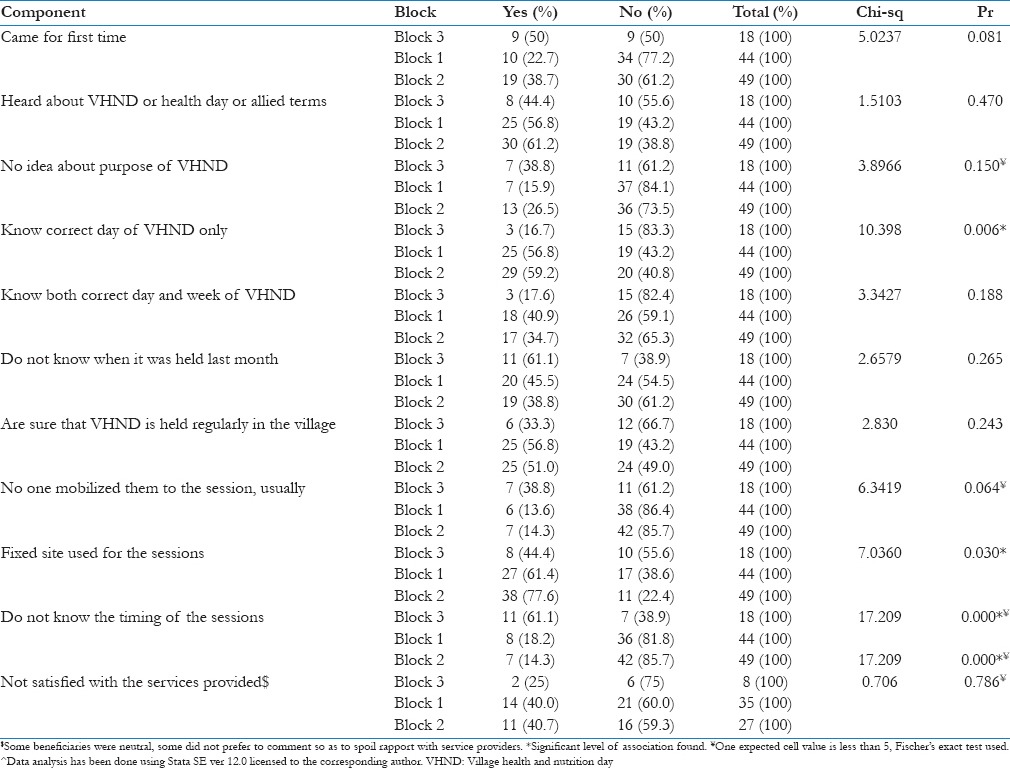
Discussion
Awareness among the service providers about any program is a mandate to deliver quality services. Awareness among beneficiaries is similarly highly essential as it ensures service utilization and health care-seeking behavior. There are no documented studies, at present, which evaluate the awareness, perception and practices of service providers and beneficiaries with regard to VHND in India. As it was observed, most of the service providers considered creating health awareness among beneficiaries and providing comprehensive health and nutrition services as the major purpose of VHND sessions. Other important objectives like convergence between health and ICDS, even, were not stressed upon.
Hence, proper orientation activities were needed for the service providers from the HFW and WCD Department. This also needs to be emphasized also in various monthly meetings. Role clarity and delineation were not observed among the services providers and need to be improved. This may lead to duplication of some activities and missing out of other. It was observed that training status of service providers was significantly poor in one of the blocks as compared to others (block 2, see Table 10). But the pattern of awareness, perception and practice found in this block was certainly not related to the training component. Some other components like mobilization by ASHA, awareness generation by service providers in the area, etc., rather may have been related to the results.
Table 10.
Training status of service providers in the blocks
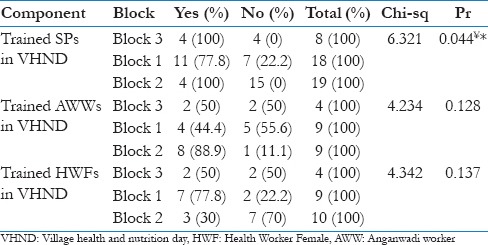
The Centre of Excellence (CoE) has been established in the State under the banner of State Institute of Health and Family Welfare to plan and implement communication activities related to national health programs.[8,9] Hence, CoE should take the lead role in creating awareness among the community members. SIHFW exists in all states, under the banner of National Institute of Health and Family Welfare, which can take leadership to create awareness. Use of Village Health and Sanitation Committee's Health Bulletin Board or “Swasthya Kantha”[10,11] or Health Wall also need to be used for dissemination of upcoming events in the village.
Community participation was very less and involvement of Panchayat Raj Institution (PRI)[12] members should be promoted. A referral was done without proper counseling on the reason for referral in many cases. Some beneficiaries also insisted on conducting VHND session taking into consideration their time convenience, especially where there were people depending on daily wages for livelihood. Hence, VHND planning should also involve community needs’ assessment which is actually practically neglected.
It was interestingly observed that a health worker took deviation to benefit the beneficiaries by changing the time schedule of the sessions. This was done on request of the Panchati Raj Institution (PRI) members. This is a good practice to note, where PRI members acted as facilitators in bestowing services.
The authors agree that the study has few limitations. Sample size for interview with referral cases was small. The evaluation of awareness and perception too might have been done too early in the stage of implementation and need to be revisited as on today for a better picture.
Conclusion
Village Health and Nutrition Day (VHND) session was found to be an important platform for RCH service delivery. But awareness among various components of services among service providers and beneficiaries was not found up to the mark. Important purposes of VHND like integration of health with ICDS, high-risk case identification, etc., were not given much priority. One third of the beneficiaries reported to have been mobilized to the sessions for the first time and were not a part of the sessions regularly which was a thing of concern. Almost a quarter were also not aware of the purpose of such a gathering on VHND, while almost half of them did not know if the VHND sessions were held regularly. Community participation in organizing the session was negligible. Reasons, in case of referral, had not been clearly explained to the beneficiaries. There was significant difference in the level of awareness among service providers and beneficiaries with respect to certain components like few important objectives of VHND and, schedule and place of conducting VHND, respectively. In spite of all these, most of the beneficiaries believed that this setup should continue included with a stronger package and quality of services since people were definitely benefited by the sessions. Hence, capacity building and orientation of service providers must be done along with that of PRI members. Communication activities to create awareness among beneficiaries should be improved.
Acknowledgement
The authors acknowledge the district health administration and Rural Health and Training Center of Jagatsinghpur district, Orissa for supporting the evaluation activity. The authors also acknowledge the role of Dr Krushna Chandra Pani, the then bio-statistician of the department for endorsing the sample size.
Footnotes
Source of Support: Nil.
Conflict of Interest: None declared.
References
- 1.Monthly Village Health Nutrition Day: Guidelines for AWWs/ANMs/PRIs. [Last cited on 2014 Dec 25]. Available from: http://www.nrhm.gov.in/images/pdf/communitisation/vhnd/vhnd_guidelines.pdf .
- 2.Village Health Nutrition Day (VHND)-Governnment of India. [Last cited on 2014 Dec 25]. Available from: http://www.nrhm.gov.in/communitisation/village-health-nutrition-day.html .
- 3.MamataDiwas- Village Health and Nutrition Day: Operational Guidelines. [Last cited on 2014 Dec 25]. Available from: http://www.angul.nic.in/Mamata Diwas.pdf .
- 4.Government of Orissa: MamataDiwas- Village Health and Nutrition Day Operational Guidelines. 2009 unpublished. [Google Scholar]
- 5.National Rural Health Mission, India: Gaon Kalyan Samiti Operational Guidelines. [Last cited on 2015 Mar 07]. Available from: http://archive.india.gov.in/allimpfrms/alldocs/10098.pdf .
- 6.Department of Health and Family Welfare, Government of Orissa: Operational Guidelines- PustikarDiwas: A child Survival Initiative. [Last cited on 2015 Mar 07]. Available from: http://angul.nic.in/pdivas.pdf .
- 7.Department of Women and Child Development, Government of Orissa: ICDS MPR Report of December. 2009 [Google Scholar]
- 8.SIHFW towards a Center of Excellence in Communication | Odisha 360 – News, Events and Complete Information About the State. [Last cited on 2014 Dec 25]. Available from: http://www.odisha360.com/2011/12/17/sihfw-towards-acenter-of-excellence-in-communication/
- 9.SIHFW | New Concept. [Last cited on 2014 Dec 25]. Available from: http://newconceptinfo.com/category/keyword/sihfw .
- 10.Government of Orissa: Communication Implementation Plan 2011-12. [Last cited on 2014 Dec 25]. Available from: http://pipnrhm-mohfw.nic.in/index_files/high_focus_non_ne/Orissa/27.IEC BCC.pdf .
- 11.SwasthyaKantha Campaign in Odisha: An insight to community empowerment with innovative communication approach. [Last cited on 2014 Dec 25]. Available from: http://www.nrhmorissa.gov.in/writereaddata/Upload/Documents/Swasthya KanthaCampaign in Odisha.pdf .
- 12.Ministry of PanchayatiRaj, Govertment of India-National Panchayat Portal. [Last cited on 2014 Dec 25]. Available from: http://www.panchayat.gov.in/


